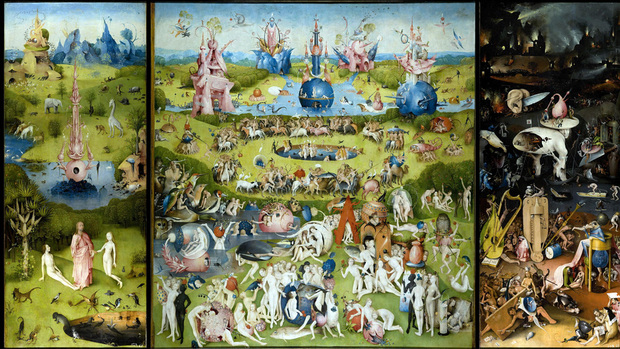Our COVID-19 World Is Like Living in a Bosch Painting
"Particularly relevant today are the people encapsulated in bubbles, remindful that we now live lockdown indoors, and outdoors with faces masked."
May 14, 2020 at 10:00 AM
4 minute read
 Hieronymus Bosch, "The Garden of Delights" (1504) (Public domain)
Hieronymus Bosch, "The Garden of Delights" (1504) (Public domain)
Hieronymus Bosch, born about 1450 in the Spanish Netherlands, was a strikingly original artist. He expanded the subject matter of painting, which was dominated by religious themes, to include scenes of everyday secular life, what is called genre painting. More startling, his depictions of everyday life included a variety of unexpected figures, drunkards and charlatans, for example, engaged in eccentric behavior—as well as otherworldly figures, aliens, composed of parts of different animals, such as the head of a bird on the body of a frog. He painted nightmares full of devilries, fantasies, oddities and chaos. In short, he often created new species inhabiting new worlds.
The unreality of living in a COVID-19 world, an unprecedented experience that contradicts the reality we have known, is like living in a Bosch painting.
Look at The Garden of Delights (1504) in the Prado, Madrid, one of the most unexpected paintings ever created. The left panel of the triptych is Eden and while it is different from traditional depictions, for example, God here appears as Christ, it nonetheless at first glance looks innocent as a variety of animals frolic in brightly colored nature. Yet, even here, in the exact center of Eden is a fantastical fountain on which an owl—medieval symbol of the devil—stares directly at the creation event, possibly suggesting a sinful future.
Piercing the puzzle of bizarre behaviors in the center panel with any confidence is impossible. Dozens of nude figures engage in nonsensical, preposterous activities: eating or fondling giant strawberry like fruit; riding bareback on a variety of animals; standing, dancing and doing acrobatics on surrealistic architectural structures; and lots of sexual foreplay, lots of it inventive.
Particularly relevant today, however, are the people encapsulated in bubbles, remindful that we now live lockdown indoors, and outdoors with faces masked. And the right panel, Hell, is grotesque, total terror, remindful of the fright we now live with.
Yet, the painting is magnetic. It was prized by the Brussels aristocratic community when painted, and today Prado crowds smother it. And that brings us to some important history—and to an interesting example of pre-trial discovery.
While Americans like to believe we were in 1776 the first colonials in the western world who rebelled for political independence, some 210 years earlier in 1566, the Dutch revolted against Spanish rule. Led by William I, Prince of Orange, aka William the Silent, William also happened to own The Garden, having inherited it from a member of the royal family in Brussels.
The next year, 1567, King Philip II of Spain sent Fernando Alvarez de Toledo, 3rd Duke of Alba, to the Netherlands to crush the Dutch rebellion. Alba established the Council of Troubles d/b/a The Court of Blood, to prosecute the rebels and confiscate their possessions. Alba, who had seen a copy of The Garden upon his arrival in Brussels became obsessed with obtaining the original.
While justified in prosecuting William for sedition, getting possession of The Garden via confiscation was an obvious twofer. But William could not be taken into custody as he was either on the battlefield or hiding—and Alba could not find the painting. Then, in the best tradition of pre-trial discovery, Alba took William's estate manager into custody and tortured him until he revealed the painting's location.
The denouement: Alba got The Garden and carried it back to Spain when he was discharged in 1573; the Netherlands got its independence eight years later; and we today delight in looking at The Garden of Delights and are remindful that Bosch also saw the world turned upside down. See Bosch & Bruegel by Joseph Leo Koerner, Princeton University Press, 2016.
David Lenefsky practices law in Manhattan. He is a resource in art history for The Young President's Organization. The author is grateful to Matthew F. Cooper, J.S.C., New York County, for suggesting the subject matter of this essay; needless to say, Judge Cooper is not responsible for its content.
This content has been archived. It is available through our partners, LexisNexis® and Bloomberg Law.
To view this content, please continue to their sites.
Not a Lexis Subscriber?
Subscribe Now
Not a Bloomberg Law Subscriber?
Subscribe Now
NOT FOR REPRINT
© 2025 ALM Global, LLC, All Rights Reserved. Request academic re-use from www.copyright.com. All other uses, submit a request to [email protected]. For more information visit Asset & Logo Licensing.
You Might Like
View All
Law Journal Column on Marital Residence Sales in Pending Divorces Puts 'Misplaced' Reliance on Two Cases
8 minute read

A Time for Action: Attorneys Must Answer MLK's Call to Defend Bar Associations and Stand for DEI Initiatives in 2025
5 minute readTrending Stories
- 1ACC CLO Survey Waves Warning Flags for Boards
- 2States Accuse Trump of Thwarting Court's Funding Restoration Order
- 3Microsoft Becomes Latest Tech Company to Face Claims of Stealing Marketing Commissions From Influencers
- 4Coral Gables Attorney Busted for Stalking Lawyer
- 5Trump's DOJ Delays Releasing Jan. 6 FBI Agents List Under Consent Order
Who Got The Work
J. Brugh Lower of Gibbons has entered an appearance for industrial equipment supplier Devco Corporation in a pending trademark infringement lawsuit. The suit, accusing the defendant of selling knock-off Graco products, was filed Dec. 18 in New Jersey District Court by Rivkin Radler on behalf of Graco Inc. and Graco Minnesota. The case, assigned to U.S. District Judge Zahid N. Quraishi, is 3:24-cv-11294, Graco Inc. et al v. Devco Corporation.
Who Got The Work
Rebecca Maller-Stein and Kent A. Yalowitz of Arnold & Porter Kaye Scholer have entered their appearances for Hanaco Venture Capital and its executives, Lior Prosor and David Frankel, in a pending securities lawsuit. The action, filed on Dec. 24 in New York Southern District Court by Zell, Aron & Co. on behalf of Goldeneye Advisors, accuses the defendants of negligently and fraudulently managing the plaintiff's $1 million investment. The case, assigned to U.S. District Judge Vernon S. Broderick, is 1:24-cv-09918, Goldeneye Advisors, LLC v. Hanaco Venture Capital, Ltd. et al.
Who Got The Work
Attorneys from A&O Shearman has stepped in as defense counsel for Toronto-Dominion Bank and other defendants in a pending securities class action. The suit, filed Dec. 11 in New York Southern District Court by Bleichmar Fonti & Auld, accuses the defendants of concealing the bank's 'pervasive' deficiencies in regards to its compliance with the Bank Secrecy Act and the quality of its anti-money laundering controls. The case, assigned to U.S. District Judge Arun Subramanian, is 1:24-cv-09445, Gonzalez v. The Toronto-Dominion Bank et al.
Who Got The Work
Crown Castle International, a Pennsylvania company providing shared communications infrastructure, has turned to Luke D. Wolf of Gordon Rees Scully Mansukhani to fend off a pending breach-of-contract lawsuit. The court action, filed Nov. 25 in Michigan Eastern District Court by Hooper Hathaway PC on behalf of The Town Residences LLC, accuses Crown Castle of failing to transfer approximately $30,000 in utility payments from T-Mobile in breach of a roof-top lease and assignment agreement. The case, assigned to U.S. District Judge Susan K. Declercq, is 2:24-cv-13131, The Town Residences LLC v. T-Mobile US, Inc. et al.
Who Got The Work
Wilfred P. Coronato and Daniel M. Schwartz of McCarter & English have stepped in as defense counsel to Electrolux Home Products Inc. in a pending product liability lawsuit. The court action, filed Nov. 26 in New York Eastern District Court by Poulos Lopiccolo PC and Nagel Rice LLP on behalf of David Stern, alleges that the defendant's refrigerators’ drawers and shelving repeatedly break and fall apart within months after purchase. The case, assigned to U.S. District Judge Joan M. Azrack, is 2:24-cv-08204, Stern v. Electrolux Home Products, Inc.
Featured Firms
Law Offices of Gary Martin Hays & Associates, P.C.
(470) 294-1674
Law Offices of Mark E. Salomone
(857) 444-6468
Smith & Hassler
(713) 739-1250







